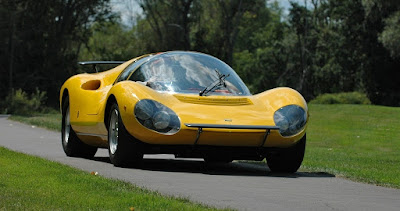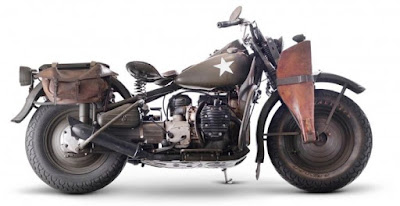After some time ago we discussed one of the car species bearing the prancing horse logo which is scarce and rarely seen to the public called the Ferrari Dino Berlinetta Speciale made by Pininfarina in 1965. Now we will discuss other Ferrari Dino cars that are no less cool, namely the 1967 Ferrari Dino 206 Competizione which is also the work of those Turin-based coachbuilder company.
 |
| The 1 of 1 1967 Ferrari Dino 206 Competizione Prototipo by Pininfarina. (Picture from: https://bit.ly/3ou1nHy) |
This car is so cool because it has a shape that is very different from the previous Ferrari Dino model, such it has a a unique fishbowl-style cockpit features and a very low driving position. This unique car was created only as a design study and not for production purposes, with many design elements clearly influenced by the 1967 Dino 206 GT.
 |
| 1966 Ferrari Dino 206 Sports Racer, on which the Competizione is built based of. (Picture from: https://bit.ly/3ou1nHy) |
At that time, Ferrari asked the Pininfarina design house to build a road-legal supercar using racing car techniques and technology. This car is designed by Paolo Martin and built on one of the 18 chassis Ferrari Dino 206SP racing cars in the 1966. It's no surprise that the designer borrowed heavily from the 206SP.
 |
| 1967 Ferrari Dino 206 Competizione has many unique features such fishbowl-style cockpit, duck-beak front wing, rear spoiler, cobalt-blue racing harnesses and also gull-wing doors. (Picture from: https://bit.ly/3ou1nHy) |
However, the Dino 206 Competizione also carries several distinctive features, such as the gull wing door styled. Originally, the car designed by Paolo Martin did not feature wings, but later that was added because Pininfarina thought wings helped the perception they were more at the forefront of racing technology. This car is now equipped with a duck-beak front wing, rear spoiler, and also cobalt-blue racing harnesses that give a more characteristic impression.
 |
| 1967 Ferrari Dino 206 Competizione with its gull-wing doors opened. (Picture from: https://bit.ly/3ou1nHy) |
The engine used is the same engine used by the 3 Ferrari Dino racing cars that competed in the 1966 LeMans race, which is a 6-cylinder mid-mounted longitudinal engine. And the fully functional Ferrari Dino 206 Competizione prototype made its first appearance in public at the 1967 Frankfurt Auto Show.
 |
| 1967 Ferrari Dino 206 Competizione uses a 6-cylinder mid-mounted longitudinal engine. (Picture from: https://bit.ly/3ou1nHy) |
After
that the Pininfarina design house kept it in their own museum in Turin
until 2007, when the famous Ferrari collector James Glickenhaus bought
it from them and sent it to the United States. Now this unique
yellow-colored car is one of Jim Glickenhaus's personal collections and
accompanies other Ferrari models that have previously been in his
collection such as the Ferrari P4/5 and P4/5 Competizione, Ferrari 512S Modulo Comcept.
That's it, and if the article above is still considered inadequate or inaccurate, or if you have additional information related to the 1967 Ferrari Dino 206 Competizione, please don't hesitate to let us know via the comments column below this article. *** [EKA | FROM VARIOUS SOURCES | 95CUSTOMS ]
Note: This blog can be accessed via your smart phone

















































